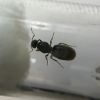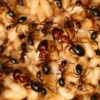I teach a unit on ants to my First Graders, and had wanted to find a queen ant all summer, but didn't have any success, and then, the third day of school, found one walking around the school garden!! The First Graders are super excited about her, and have named her Bear the Ant, and I would love help identifying her!!
I'm sorry my photographs aren't very good. The test tube I grabbed from the science room was very scratched, and I didn't focus well, but the video of her is better: https://drive.google...4Zm?usp=sharing
Please let me know if there is anything else I can share!
1. Location (on a map) of collection: San Francisco, CA
2. Date of collection: August 29th
3. Habitat of collection: A school garden in a fairly urban part of the city
4. Length (from head to gaster): About 8mm? (I didn't actually measure)
5. Color, hue, pattern and texture: She looked rather golden and almost velvet-y when I was holding her, but in the test tube I can't really see that any more
6. Distinguishing characteristics:
7. Distinguishing behavior: When I checked her today (Sept 7), she had already laid eggs
8. Nest description: She was just walking on a stone path in the garden
9. Nuptial flight time and date:






















